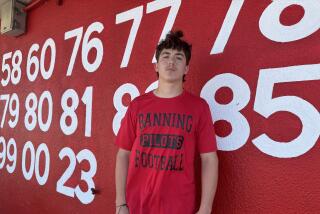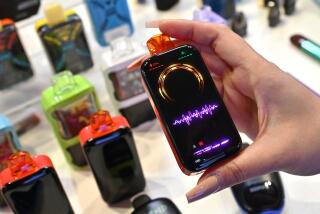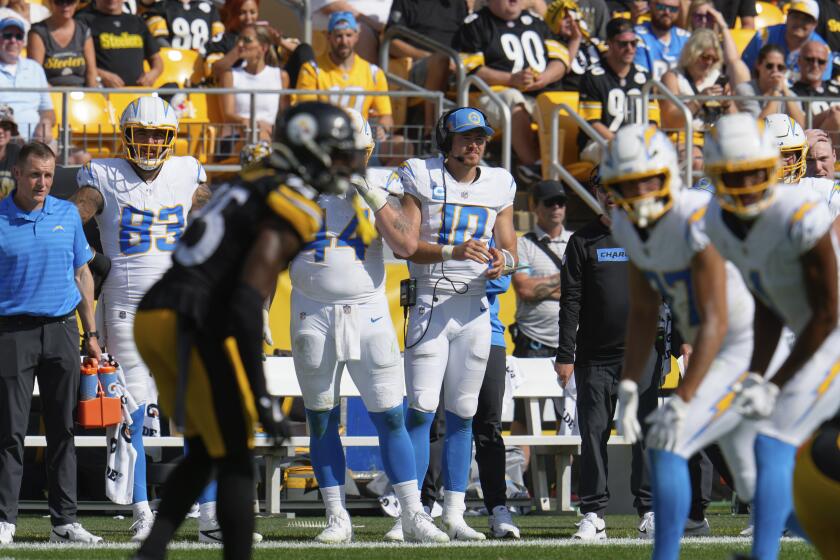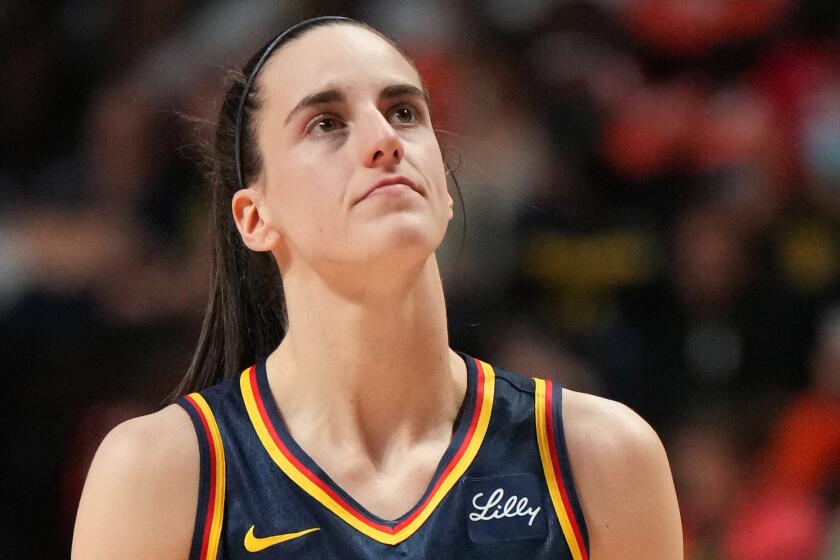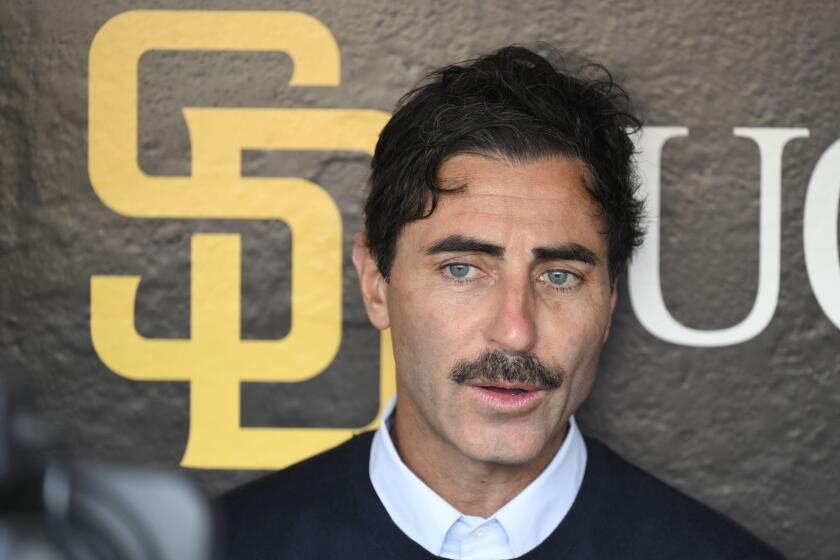In the sports concussion issue, a teen enters the game
No one had to tell Braeden Benedict that concussions are an issue in youth football.
Twice in the last two seasons, the 15-year-old watched teammates suffer from what coaches call “getting your bell rung.” Even scarier, his friends continued to play, unaware of their injuries until later, when headaches set in.
“I’m thinking, ‘Well, this is a problem,’” Benedict said. “What can we do?”
Bright and articulate, this Palos Verdes Peninsula High freshman barely weighs 100 pounds and looks more like an honors student than a fullback.
With a little reading, Benedict learned that even minor head trauma, if undetected, can lead to long-term damage. He found that researchers had developed an array of new technology, tiny sensors that fit into helmets and chin straps, some equipped to transmit impact data to the sideline.
Though these devices might suit college and professional teams, they can be too expensive for youth sports. Benedict said: “I wanted to come up with something simple and low-cost. Something that tells you to get out of the game and get checked.”
The thin, liquid-filled patch he designed — it sticks to the front of a helmet — won a $25,000 national science contest last fall and is now being patented. As one major concussion researcher said, “It’s pretty cool that a high school kid has done something like this.”
But Benedict has ventured into a tremendously complex field. Even veteran scientists are still grappling with how to make their high-tech devices actually protect athletes.
“We’re trying to figure out all of the factors for a concussive injury,” said Kevin Guskiewicz, a University of North Carolina professor who received a 2011 MacArthur Foundation “genius” grant for his work in the field. “It has been rather elusive.”
The timely detection of a concussion is vital because athletes who return to action too soon are vulnerable to repeat injuries. The damage can lurk inside, later surfacing as memory loss, a change in personality, depression and the early onset of dementia.
The federal Centers for Disease Control and Prevention estimate that nearly a quarter-million youths 19 and under visited the emergency room for sports- and recreation-related concussions in 2009. Medical experts suspect a far greater number did not seek medical attention or did not receive a diagnosis.
Contact sports such as football, lacrosse and hockey present significant risks.
That is where helmet technology comes in.
For years, researchers have been mounting accelerometers in helmets to study various types of impacts. At one time, they hoped to find a magic number.
But their work showed that a hit measuring 60 G-forces could injure one player, while a hit of well over 100 G-forces had no effect on another. Angle and duration of impact seemed to play a role, as did physiological and perhaps genetic differences between athletes.
“There are so many factors that go into what causes a concussion,” said Dr. David Kruse, who until recently served as medical director of UC Irvine’s Orthopaedic and Sports Medicine Center. “Having a simple monitor that shows a threshold of impact is really hard.”
For now, the goal has changed.
While scientists continue to compile data, hoping to refine their knowledge of brain injuries, coaches can use the technology in more subtle ways. Some available devices transmit directly to smartphones on the bench, so they can watch a player who has recorded a significant impact. If that player shows signs of injury, he can be pulled off the field, where another smartphone app helps with conducting an exam.
Even in the absence of a concussion, multiple big hits might alert a coach to focus on a specific athlete’s technique.
“It might allow us to say, ‘OK, for the past two weeks look at the impact you’re taking on the crown of the head,’” Guskiewicz said. “So let’s change the way you are blocking and tackling.”
But tracking systems can cost hundreds or even thousands of dollars per athlete. Benedict envisioned something more affordable.
The son of aerospace engineers — and a veteran of science fairs — he set to work last spring with a device common to the shipping industry: A small sensor that detects when crates have been dropped hard enough to damage their contents. He wondered if this idea could be adapted to football and lacrosse helmets.
Benedict made a two-minute video describing his concept and was selected among 10 finalists in the Discovery Education 3M Young Scientist Challenge. Over the summer, a 3M researcher named Martin Wolk helped him develop a prototype.
“I thought it was a timely concept,” Wolk said. “I realized how sharp a kid he is.”
Through weeks of trial and error, Benedict constructed a drop-tester in his frontyard and experimented with various materials. The liquid mechanical sensor he developed attaches to the helmet at forehead level and works simply: A hard jolt releases red dye that spreads across the inside of a clear patch, creating a marker that coaches can see from across the field.
His teammates were impressed; so were their families.
“I had a whole bunch of parents coming up to me,” he said. “They were asking, ‘When are we going to get this?’”
Since taking the contest’s top prize, and visiting the White House, Benedict has used part of his winnings to begin the patent process. But he understands there is much work to do.
Deciding upon an impact threshold to release the dye could prove tricky. A low number would have coaches yanking athletes off the field on every play — there might not be enough bodies to keep the game going. Even worse, a high threshold might miss potential concussions.
Guskiewicz has another concern about devices — such as a recently marketed chin strap with colored lights — that display their results for all to see: “We might have players who make this a game,” he said. “They’ll say, ‘I’m going to light you up.’”
But the North Carolina researcher and others like him praise Benedict’s initiative and hope that he continues trying to develop his invention.
“Our understanding of the brain needs to advance,” said Dr. Gerard Gioia, director of neuropsychology at the Children’s National Medical Center in Washington. “We’re going to need all hands on deck.”
They don’t have to explain the importance of the work to Benedict. While developing his prototype last summer, he was attending daily football practice as a fullback, safety and kicker.
One day, a hard collision had him seeing stars. He thought “Oh, no” and waited for the headaches to start. Everything turned out all right, but, he says, “It makes you think.”
twitter.com/LATimesWharton
More to Read
Go beyond the scoreboard
Get the latest on L.A.'s teams in the daily Sports Report newsletter.
You may occasionally receive promotional content from the Los Angeles Times.
